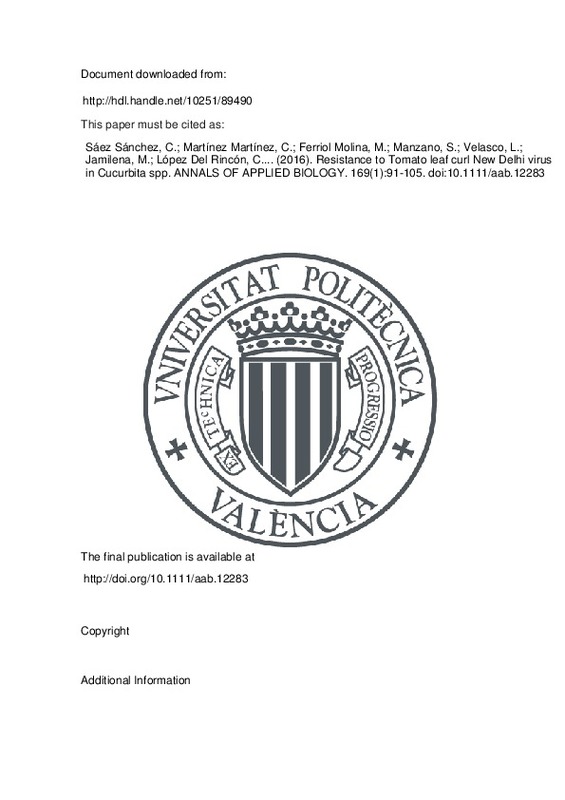JavaScript is disabled for your browser. Some features of this site may not work without it.
Buscar en RiuNet
Listar
Mi cuenta
Estadísticas
Ayuda RiuNet
Admin. UPV
Resistance to Tomato leaf curl New Delhi virus in Cucurbita spp
Mostrar el registro sencillo del ítem
Ficheros en el ítem
| dc.contributor.author | Sáez Sánchez, Cristina
|
es_ES |
| dc.contributor.author | Martínez Martínez, Cecilia
|
es_ES |
| dc.contributor.author | Ferriol Molina, María
|
es_ES |
| dc.contributor.author | Manzano, S.
|
es_ES |
| dc.contributor.author | Velasco, L.
|
es_ES |
| dc.contributor.author | Jamilena, M.
|
es_ES |
| dc.contributor.author | López Del Rincón, Carmelo
|
es_ES |
| dc.contributor.author | Picó Sirvent, María Belén
|
es_ES |
| dc.date.accessioned | 2017-10-19T07:10:29Z | |
| dc.date.available | 2017-10-19T07:10:29Z | |
| dc.date.issued | 2016 | es_ES |
| dc.identifier.issn | 0003-4746 | es_ES |
| dc.identifier.uri | http://hdl.handle.net/10251/89490 | |
| dc.description.abstract | [EN] Tomato leaf curl New Delhi virus (ToLCNDV) is a bipartite begomovirus (family Geminiviridae) first reported in India and its neighbouring countries. ToLCNDV severely affects zucchini crop (Cucurbita pepo) in the main production areas of Southern Spain since 2012. This emerging begomovirus is a serious threat to this and other cucurbit crops. Breeding resistant cultivars is the most promising method for disease control, but requires the identification of sources of resistance in the Cucurbita genus. In this work, we screened for ToLCNDV resistance a large collection of Cucurbita spp. accessions, including landraces and commercial cultivars of the main cultivated species, C. pepo, Cucurbita moschata and Cucurbita maxima and wild species. The screening was performed using mechanical and whitefly inoculation. The level of resistance was assessed by scoring symptom severity and bymeasuring the virus content with quantitative polymerase chain reaction in selected genotypes. Diversity in the response was observed within and among species. Severe symptoms and high viral amounts were found at 30 days after mechanical and whitefly inoculation in C. pepo, in all accessions belonging to the Zucchini morphotype and to other morphotypes of both subspecies, pepo and ovifera, and even in the wild relative Cucurbita fraterna. C. maxima was also highly susceptible. This species showed characteristic symptoms of leaf decay and intense yellowing, different from those of mosaic, curling and internode shortening found in C. pepo. The only species showing resistance was C. moschata. Four accessions were symptomless or had some plants with only mild symptoms after three independent rounds of mechanical inoculation with different inoculum sources. Two of them also remained symptomless after virus inoculation with viruliferous whiteflies. ToLCNDV was detected in these asymptomatic accessions at 15 and 30 days post inoculation, but viral amounts were much lower than those found in susceptible genotypes, suggesting a high level of resistance. The symptoms in the susceptible accessions of this specieswere also different, with a characteristic leaf mottling, evolving to a severe mosaic. The newly identified C. moschata resistant accessions are good candidates for breeding programmes to avoid the damage caused by ToLCNDV. | es_ES |
| dc.description.sponsorship | This work was supported by Projects E_RTAE2013-00020-C04-03 and E-RTA2013-00020-C04-01 from the Spanish Instituto Nacional de Investigaciones Agrarias (INIA) cofunded with FEDER funds. | en_EN |
| dc.language | Inglés | es_ES |
| dc.relation.ispartof | ANNALS OF APPLIED BIOLOGY | es_ES |
| dc.rights | Reserva de todos los derechos | es_ES |
| dc.subject | Agroinoculation | es_ES |
| dc.subject | Mechanical inoculation | es_ES |
| dc.subject | Resistance | es_ES |
| dc.subject | Squash | es_ES |
| dc.subject | ToLCNDV | es_ES |
| dc.subject | Whitefly transmission | es_ES |
| dc.subject | Zucchini | es_ES |
| dc.subject.classification | GENETICA | es_ES |
| dc.subject.classification | BOTANICA | es_ES |
| dc.subject.classification | MICROBIOLOGIA | es_ES |
| dc.title | Resistance to Tomato leaf curl New Delhi virus in Cucurbita spp | es_ES |
| dc.type | Artículo | es_ES |
| dc.identifier.doi | 10.1111/aab.12283 | es_ES |
| dc.relation.projectID | info:eu-repo/grantAgreement/MINECO//RTA2013-00020-C04-03/ES/Identificación de resistencias a ToLCNDV en Cucurbitáceas y análisis genético de las mismas/ | |
| dc.relation.projectID | info:eu-repo/grantAgreement/MINECO//RTA2013-00020-C04-01/ES/Epidemiologia y control de Tomato leaf curl New Delhi virus/ | |
| dc.rights.accessRights | Abierto | es_ES |
| dc.contributor.affiliation | Universitat Politècnica de València. Departamento de Biotecnología - Departament de Biotecnologia | es_ES |
| dc.contributor.affiliation | Universitat Politècnica de València. Departamento de Ecosistemas Agroforestales - Departament d'Ecosistemes Agroforestals | es_ES |
| dc.contributor.affiliation | Universitat Politècnica de València. Instituto Universitario de Conservación y Mejora de la Agrodiversidad Valenciana - Institut Universitari de Conservació i Millora de l'Agrodiversitat Valenciana | es_ES |
| dc.description.bibliographicCitation | Sáez Sánchez, C.; Martínez Martínez, C.; Ferriol Molina, M.; Manzano, S.; Velasco, L.; Jamilena, M.; López Del Rincón, C.... (2016). Resistance to Tomato leaf curl New Delhi virus in Cucurbita spp. ANNALS OF APPLIED BIOLOGY. 169(1):91-105. https://doi.org/10.1111/aab.12283 | es_ES |
| dc.description.accrualMethod | S | es_ES |
| dc.relation.publisherversion | http://doi.org/10.1111/aab.12283 | es_ES |
| dc.description.upvformatpinicio | 91 | es_ES |
| dc.description.upvformatpfin | 105 | es_ES |
| dc.type.version | info:eu-repo/semantics/publishedVersion | es_ES |
| dc.description.volume | 169 | es_ES |
| dc.description.issue | 1 | es_ES |
| dc.relation.pasarela | S\313549 | es_ES |
| dc.contributor.funder | Ministerio de Economía y Competitividad |







![[Cerrado]](/themes/UPV/images/candado.png)

